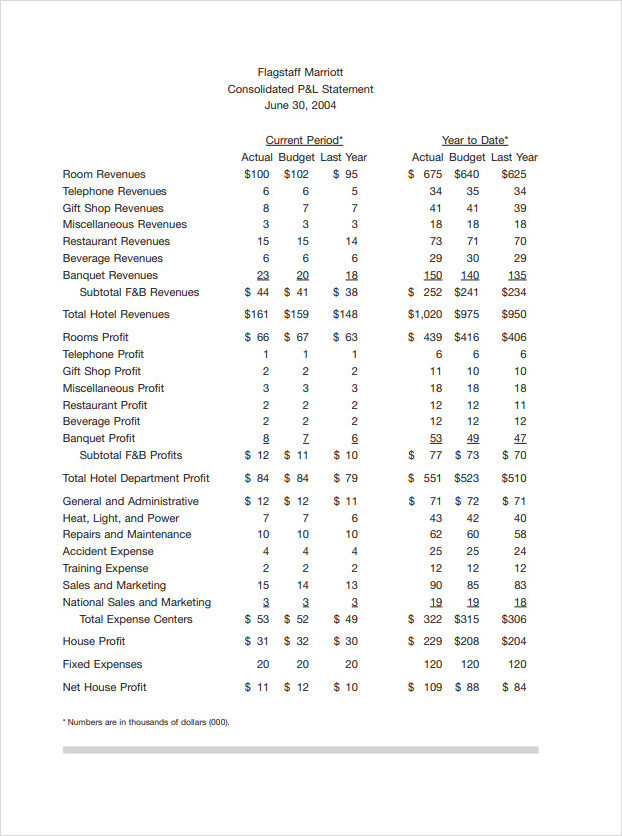
A profit and loss statement, also known as an income statement, is a financial document that summarizes the revenue, costs, and expenses incurred during a specific time. It provides valuable insights into the financial performance of a business and is essential for making informed decisions.
In the restaurant industry, where profit margins can be slim, having a clear understanding of your financials is crucial for success. A restaurant profit and loss statement can help you track your restaurant’s financial health and identify areas for improvement.
What is a Restaurant Profit and Loss Statement?
A restaurant profit and loss statement is a document that outlines the revenue, costs, and expenses of a restaurant over a specific period. It provides a snapshot of the financial performance of the business and helps restaurant owners and managers evaluate their profitability.
The statement typically includes information such as total sales, cost of goods sold, operating expenses, and net profit or loss.
Why is a Restaurant Profit and Loss Statement Important?
A restaurant profit and loss statement is important for several reasons:
- Financial Analysis: It allows restaurant owners and managers to analyze the financial performance of their business. By comparing the revenue, costs, and expenses over different periods, they can identify trends and make informed decisions.
- Budgeting and Planning: It helps in budgeting and planning for the future. By analyzing the profit and loss statement, restaurant owners can set realistic financial goals and allocate resources accordingly.
- Identifying Areas for Improvement: It helps in identifying areas where the restaurant can improve its profitability. By analyzing the costs and expenses, owners can identify areas of inefficiency and take corrective actions.
- Tracking Performance: It allows restaurant owners to track their performance against industry benchmarks. By comparing their financials with industry averages, they can assess their competitive position and make necessary adjustments.
- Financial Reporting: It provides a clear and concise summary of the restaurant’s financial performance, which is important for reporting to stakeholders such as investors, lenders, and tax authorities.
How to Create a Restaurant Profit and Loss Statement
Creating a restaurant profit and loss statement involves several steps:
- Gather Financial Data: Collect all the necessary financial data, including sales records, invoices, receipts, and expense reports. Make sure to categorize the expenses correctly to ensure accurate reporting.
- Calculate Revenue: Calculate the total revenue for the period by adding up all the sales. This includes both food and beverage sales, as well as any other sources of revenue such as catering or merchandise sales.
- Determine Cost of Goods Sold: Calculate the cost of goods sold (COGS), which includes the direct costs associated with producing the food and beverages sold. This typically includes the cost of ingredients, packaging, and any other direct expenses.
- Calculate Gross Profit: Subtract the cost of goods sold from the total revenue to calculate the gross profit. This represents the profit generated from the sale of goods before deducting operating expenses.
- Determine Operating Expenses: Identify and categorize all the operating expenses, such as rent, utilities, payroll, marketing, and insurance. Make sure to include both fixed and variable expenses.
- Calculate Net Profit or Loss: Subtract the operating expenses from the gross profit to calculate the net profit or loss. This represents the final profit or loss generated by the restaurant during the specified period.
- Format the Statement: Format the profit and loss statement in a clear and organized manner. Include headings for each section and use subtotals to summarize different categories of expenses.
- Print and Review: Print the profit and loss statement and review it for accuracy and completeness. Make any necessary adjustments and keep a copy for future reference.
Examples
Here are some examples of a restaurant profit and loss statement:












Tips for Successful Financial Management in the Restaurant Industry
Managing the finances of a restaurant can be challenging, but with the right strategies, it can be done successfully. Here are some tips for effective financial management:
- Track Expenses: Keep a close eye on your expenses and regularly review them to identify any areas of waste or inefficiency. Look for opportunities to reduce costs without compromising the quality of your food and service.
- Monitor Cash Flow: Cash flow is critical for the survival of any business, especially in the restaurant industry where expenses can fluctuate. Maintain a cash flow forecast to ensure you have enough funds to cover your expenses and make necessary investments.
- Control Inventory: Implement inventory management systems to track your food and beverage inventory. This will help you minimize waste, prevent theft, and ensure you always have the right amount of ingredients on hand.
- Analyze Menu Performance: Regularly analyze the performance of your menu items to identify your most profitable dishes. Focus on promoting these items and consider eliminating or reworking items that are not generating enough revenue.
- Invest in Technology: Embrace technology to streamline your operations and improve efficiency. Use restaurant management software for tasks like inventory management, payroll processing, and financial reporting.
- Stay Informed: Stay up to date with industry trends and regulations that may impact your business. Attend industry conferences, join professional associations, and network with other restaurant owners to stay informed and learn from their experiences.
Free Restaurant Profit and Loss Statement Template!
A restaurant profit and loss statement is a valuable tool for managing the financial health of a restaurant. It provides insights into the revenue, costs, and expenses of the business and helps in making informed decisions.
By creating and analyzing a profit and loss statement, restaurant owners can identify areas for improvement, set realistic financial goals, and ensure the long-term success of their business.
Restaurant Profit and Loss Statement Template – Download